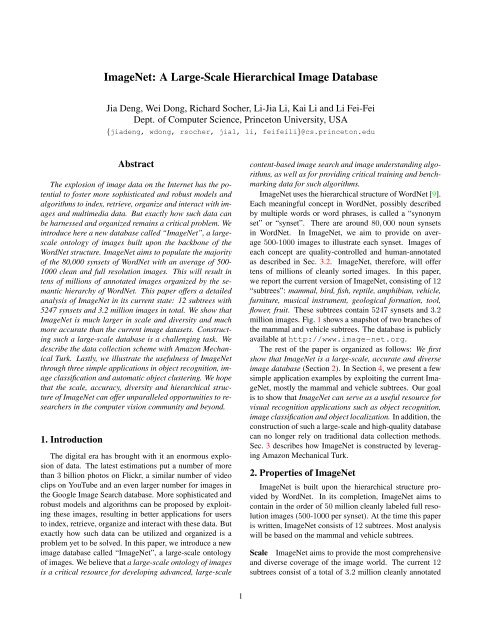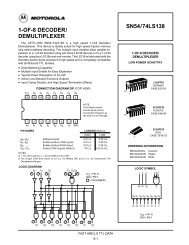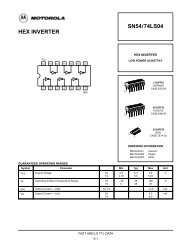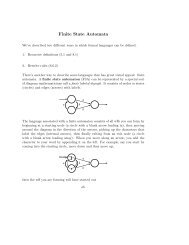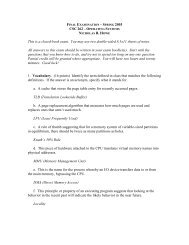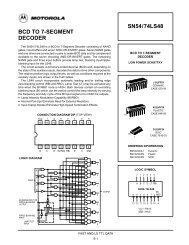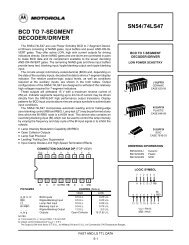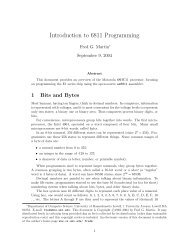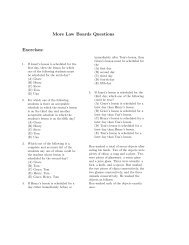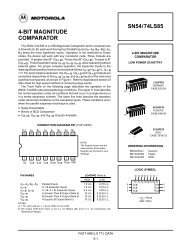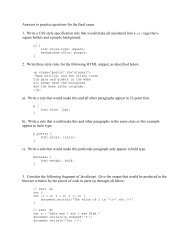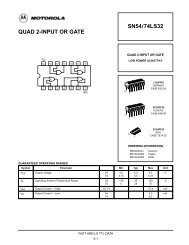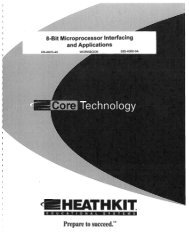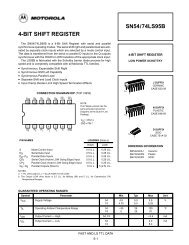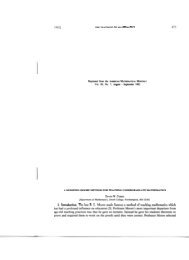ImageNet: A Large-Scale Hierarchical Image Database
ImageNet: A Large-Scale Hierarchical Image Database
ImageNet: A Large-Scale Hierarchical Image Database
You also want an ePaper? Increase the reach of your titles
YUMPU automatically turns print PDFs into web optimized ePapers that Google loves.
<strong><strong>Image</strong>Net</strong>: A <strong>Large</strong>-<strong>Scale</strong> <strong>Hierarchical</strong> <strong>Image</strong> <strong>Database</strong><br />
Jia Deng, Wei Dong, Richard Socher, Li-Jia Li, Kai Li and Li Fei-Fei<br />
Dept. of Computer Science, Princeton University, USA<br />
{jiadeng, wdong, rsocher, jial, li, feifeili}@cs.princeton.edu<br />
Abstract<br />
The explosion of image data on the Internet has the potential<br />
to foster more sophisticated and robust models and<br />
algorithms to index, retrieve, organize and interact with images<br />
and multimedia data. But exactly how such data can<br />
be harnessed and organized remains a critical problem. We<br />
introduce here a new database called “<strong><strong>Image</strong>Net</strong>”, a largescale<br />
ontology of images built upon the backbone of the<br />
WordNet structure. <strong><strong>Image</strong>Net</strong> aims to populate the majority<br />
of the 80,000 synsets of WordNet with an average of 500-<br />
1000 clean and full resolution images. This will result in<br />
tens of millions of annotated images organized by the semantic<br />
hierarchy of WordNet. This paper offers a detailed<br />
analysis of <strong><strong>Image</strong>Net</strong> in its current state: 12 subtrees with<br />
5247 synsets and 3.2 million images in total. We show that<br />
<strong><strong>Image</strong>Net</strong> is much larger in scale and diversity and much<br />
more accurate than the current image datasets. Constructing<br />
such a large-scale database is a challenging task. We<br />
describe the data collection scheme with Amazon Mechanical<br />
Turk. Lastly, we illustrate the usefulness of <strong><strong>Image</strong>Net</strong><br />
through three simple applications in object recognition, image<br />
classification and automatic object clustering. We hope<br />
that the scale, accuracy, diversity and hierarchical structure<br />
of <strong><strong>Image</strong>Net</strong> can offer unparalleled opportunities to researchers<br />
in the computer vision community and beyond.<br />
1. Introduction<br />
The digital era has brought with it an enormous explosion<br />
of data. The latest estimations put a number of more<br />
than 3 billion photos on Flickr, a similar number of video<br />
clips on YouTube and an even larger number for images in<br />
the Google <strong>Image</strong> Search database. More sophisticated and<br />
robust models and algorithms can be proposed by exploiting<br />
these images, resulting in better applications for users<br />
to index, retrieve, organize and interact with these data. But<br />
exactly how such data can be utilized and organized is a<br />
problem yet to be solved. In this paper, we introduce a new<br />
image database called “<strong><strong>Image</strong>Net</strong>”, a large-scale ontology<br />
of images. We believe that a large-scale ontology of images<br />
is a critical resource for developing advanced, large-scale<br />
1<br />
content-based image search and image understanding algorithms,<br />
as well as for providing critical training and benchmarking<br />
data for such algorithms.<br />
<strong><strong>Image</strong>Net</strong> uses the hierarchical structure of WordNet [9].<br />
Each meaningful concept in WordNet, possibly described<br />
by multiple words or word phrases, is called a “synonym<br />
set” or “synset”. There are around 80, 000 noun synsets<br />
in WordNet. In <strong><strong>Image</strong>Net</strong>, we aim to provide on average<br />
500-1000 images to illustrate each synset. <strong>Image</strong>s of<br />
each concept are quality-controlled and human-annotated<br />
as described in Sec. 3.2. <strong><strong>Image</strong>Net</strong>, therefore, will offer<br />
tens of millions of cleanly sorted images. In this paper,<br />
we report the current version of <strong><strong>Image</strong>Net</strong>, consisting of 12<br />
“subtrees”: mammal, bird, fish, reptile, amphibian, vehicle,<br />
furniture, musical instrument, geological formation, tool,<br />
flower, fruit. These subtrees contain 5247 synsets and 3.2<br />
million images. Fig. 1 shows a snapshot of two branches of<br />
the mammal and vehicle subtrees. The database is publicly<br />
available at http://www.image-net.org.<br />
The rest of the paper is organized as follows: We first<br />
show that <strong><strong>Image</strong>Net</strong> is a large-scale, accurate and diverse<br />
image database (Section 2). In Section 4, we present a few<br />
simple application examples by exploiting the current <strong><strong>Image</strong>Net</strong>,<br />
mostly the mammal and vehicle subtrees. Our goal<br />
is to show that <strong><strong>Image</strong>Net</strong> can serve as a useful resource for<br />
visual recognition applications such as object recognition,<br />
image classification and object localization. In addition, the<br />
construction of such a large-scale and high-quality database<br />
can no longer rely on traditional data collection methods.<br />
Sec. 3 describes how <strong><strong>Image</strong>Net</strong> is constructed by leveraging<br />
Amazon Mechanical Turk.<br />
2. Properties of <strong><strong>Image</strong>Net</strong><br />
<strong><strong>Image</strong>Net</strong> is built upon the hierarchical structure provided<br />
by WordNet. In its completion, <strong><strong>Image</strong>Net</strong> aims to<br />
contain in the order of 50 million cleanly labeled full resolution<br />
images (500-1000 per synset). At the time this paper<br />
is written, <strong><strong>Image</strong>Net</strong> consists of 12 subtrees. Most analysis<br />
will be based on the mammal and vehicle subtrees.<br />
<strong>Scale</strong> <strong><strong>Image</strong>Net</strong> aims to provide the most comprehensive<br />
and diverse coverage of the image world. The current 12<br />
subtrees consist of a total of 3.2 million cleanly annotated
mammal placental carnivore canine dog working dog husky<br />
vehicle craft watercraft sailing vessel sailboat trimaran<br />
Figure 1: A snapshot of two root-to-leaf branches of <strong><strong>Image</strong>Net</strong>: the top row is from the mammal subtree; the bottom row is from the<br />
vehicle subtree. For each synset, 9 randomly sampled images are presented.<br />
percentage<br />
0.2<br />
0.15<br />
0.1<br />
0.05<br />
Summary of selected subtrees<br />
Subtree<br />
Avg. synset<br />
# Synsets<br />
size<br />
Total #<br />
image<br />
Mammal 1170 737 862K<br />
Vehicle 520 610 317K<br />
GeoForm 176 436 77K<br />
Furniture 197 797 157K<br />
Bird 872 809 705K<br />
MusicInstr 164 672 110K<br />
0<br />
0 500 1000 1500 2000 2500<br />
# images per synset<br />
Figure 2: <strong>Scale</strong> of <strong><strong>Image</strong>Net</strong>. Red curve: Histogram of number<br />
of images per synset. About 20% of the synsets have very few<br />
images. Over 50% synsets have more than 500 images. Table:<br />
Summary of selected subtrees. For complete and up-to-date statistics<br />
visit http://www.image-net.org/about-stats.<br />
images spread over 5247 categories (Fig. 2). On average<br />
over 600 images are collected for each synset. Fig. 2 shows<br />
the distributions of the number of images per synset for the<br />
current <strong><strong>Image</strong>Net</strong> 1 . To our knowledge this is already the<br />
largest clean image dataset available to the vision research<br />
community, in terms of the total number of images, number<br />
of images per category as well as the number of categories 2 .<br />
Hierarchy <strong><strong>Image</strong>Net</strong> organizes the different classes of<br />
images in a densely populated semantic hierarchy. The<br />
main asset of WordNet [9] lies in its semantic structure, i.e.<br />
its ontology of concepts. Similarly to WordNet, synsets of<br />
images in <strong><strong>Image</strong>Net</strong> are interlinked by several types of relations,<br />
the “IS-A” relation being the most comprehensive<br />
and useful. Although one can map any dataset with cate-<br />
1 About 20% of the synsets have very few images, because either there<br />
are very few web images available, e.g. “vespertilian bat”, or the synset by<br />
definition is difficult to be illustrated by images, e.g. “two-year-old horse”.<br />
2 It is claimed that the ESP game [25] has labeled a very large number<br />
of images, but only a subset of 60K images are publicly available.<br />
ESP Cat Subtree<br />
376<br />
ESP Cattle Subtree <strong>Image</strong>net Cattle Subtree<br />
176<br />
1830<br />
1377<br />
<strong>Image</strong>net Cat Subtree<br />
Figure 3: Comparison of the “cat” and “cattle” subtrees between<br />
ESP [25] and <strong><strong>Image</strong>Net</strong>. Within each tree, the size of a node is<br />
proportional to the number of images it contains. The number of<br />
images for the largest node is shown for each tree. Shared nodes<br />
between an ESP tree and an <strong><strong>Image</strong>Net</strong> tree are colored in red.<br />
gory labels into a semantic hierarchy by using WordNet, the<br />
density of <strong><strong>Image</strong>Net</strong> is unmatched by others. For example,<br />
to our knowledge no existing vision dataset offers images of<br />
147 dog categories. Fig. 3 compares the “cat” and “cattle”<br />
subtrees of <strong><strong>Image</strong>Net</strong> and the ESP dataset [25]. We observe<br />
that <strong><strong>Image</strong>Net</strong> offers much denser and larger trees.<br />
Accuracy We would like to offer a clean dataset at all<br />
levels of the WordNet hierarchy. Fig. 4 demonstrates the<br />
labeling precision on a total of 80 synsets randomly sampled<br />
at different tree depths. An average of 99.7% precision<br />
is achieved on average. Achieving a high precision for<br />
all depths of the <strong><strong>Image</strong>Net</strong> tree is challenging because the<br />
lower in the hierarchy a synset is, the harder it is to classify,<br />
e.g. Siamese cat versus Burmese cat.<br />
Diversity <strong><strong>Image</strong>Net</strong> is constructed with the goal that objects<br />
in images should have variable appearances, positions,


